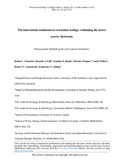JavaScript is disabled for your browser. Some features of this site may not work without it.
| dc.contributor.author | Chazdon, Robin L. | |
| dc.contributor.author | Falk, Donald A. | |
| dc.contributor.author | Banin, Lindsay F. | |
| dc.contributor.author | Wagner, Markus | |
| dc.contributor.author | Wilson, Sarah | |
| dc.contributor.author | Grabowski, Robert C. | |
| dc.contributor.author | Suding, Katherine N. | |
| dc.date.accessioned | 2021-08-24T11:54:11Z | |
| dc.date.available | 2021-08-24T11:54:11Z | |
| dc.date.issued | 2021-08-21 | |
| dc.identifier.citation | Chazdon RL, Falk DA, Banin LF, et al., (2021)The intervention continuum in restoration ecology: rethinking the active-passive dichotomy. Restoration Ecology, Available online 21 August 2021, Article number e13535 | en_UK |
| dc.identifier.issn | 1061-2971 | |
| dc.identifier.uri | https://doi.org/10.1111/rec.13535 | |
| dc.identifier.uri | http://dspace.lib.cranfield.ac.uk/handle/1826/17032 | |
| dc.description.abstract | The distinction often made between active and passive restoration approaches is a false dichotomy that persists in much research, policy and financial structures today. We explore the contradictions imposed by this terminology, and the merits of replacing this dichotomy with a continuum-based intervention framework. In practice, the main distinction between “passive” and “active” restoration lies primarily in the timing and extent of human interventions. We apply the intervention continuum framework to forest, grassland, stream, and peatland ecosystems, emphasizing that a range of restoration approaches within the scope of ecological or ecosystem restoration are typically employed in most projects, and all can contribute to the recovery of native ecosystems and prevention of further degradation. As restoration is fundamentally about the recovery of ecosystems, eliminating human sources of degradation is essential to enable ecosystem recovery processes, regardless of subsequent interventions that may be needed to assist recovery. Our review of restoration practices involving different levels of intervention highlights the benefits of recognizing a broader suite of restoration interventions in the financial and policy frameworks that currently underpin restoration activity. Effective restoration interventions emerge from an understanding of nature's intrinsic recovery potential and overcoming specific obstacles that limit this potential. | en_UK |
| dc.language.iso | en | en_UK |
| dc.publisher | Wiley | en_UK |
| dc.rights | Attribution-NonCommercial 4.0 International | * |
| dc.rights.uri | http://creativecommons.org/licenses/by-nc/4.0/ | * |
| dc.subject | Succession | en_UK |
| dc.subject | restoration strategy | en_UK |
| dc.subject | passive restoration | en_UK |
| dc.subject | ecosystem recovery | en_UK |
| dc.subject | ecosystem degradation | en_UK |
| dc.title | The intervention continuum in restoration ecology: rethinking the active-passive dichotomy | en_UK |
| dc.type | Article | en_UK |
Files in this item
The following license files are associated with this item:
This item appears in the following Collection(s)
-
Staff publications (SWEE) [2825]

